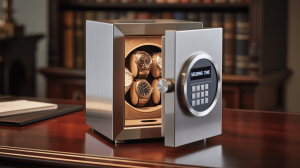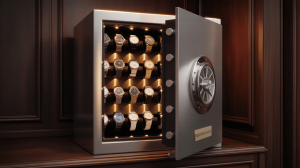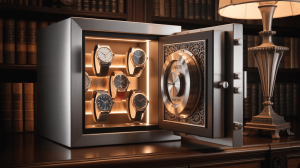Safe for Watches: A Blend of Functionality and Elegance. But here’s the kicker… Your cherished timepieces deserve a sanctuary that safeguards them with uncompromising security while reflecting your personal style. This guide reveals the features you shouldn’t compromise on when choosing the perfect watch safe.
1. Certified Security Ratings
Before anything else, verify independent certifications. A top watch safe carries UL RSC or ETL burglary ratings signaling proven resistance against common tools for at least five minutes. Electronic locks often include time‑delay functions; mechanical dials never rely on power; biometric scanners ensure fingertip access. Concealed anchor points let you bolt the safe to floors, walls, or custom furniture, deterring even determined thieves.
| Certification | Protection Type | Resistance Time |
|---|---|---|
| UL RSC | Burglary resistance | ≥ 5 minutes |
| ETL Burglary | Equivalent standard | Verified |
2. Fire and Heat Insulation
Luxury watches can’t withstand extreme heat or smoke. Seek UL 72 Class 350 ratings—30 minutes at 1,200 °F or longer durations for maximum safety. Insulating layers of gypsum board or ceramic composites block heat transfer, keeping interior temperatures below 350 °F. Intumescent gaskets expand under heat, sealing gaps against smoke and flames.
3. Climate and Humidity Control
Leather straps and metal components demand stable environments. IP54‑rated seals block dust and splashes, while integrated desiccant chambers or removable silica‑gel packs maintain relative humidity under 50%. Premium models add digital hygrometers for real‑time monitoring and Peltier dehumidifier modules for active moisture control, preventing corrosion and material degradation.
4. Tailored Size and Interior Capacity
Measure your current collection plus anticipated acquisitions. Account for pillow height (~1.5–2 inches) and extra space for straps, tools, or paperwork. Compact safes (6×8×6 inches) hold 2–4 watches; medium (8×10×8) fits 4–6; larger (10×12×8) accommodates 6–10. Modular foam trays and removable inserts let you reconfigure as your collection grows.
| Dimensions (W×D×H) | Watch Capacity | Extra Storage |
|---|---|---|
| 6×8×6 in | 2–4 | Small tools, straps |
| 8×10×8 in | 4–6 | Pockets for paperwork |
5. Interior Organization and Protection
A well‑designed interior prevents scratches and tangles. Use high‑density foam or velvet‑lined pillows sized to each case diameter. Adjustable trays let you reposition slots for different watch sizes. Hidden compartments beneath trays store warranty cards, spring bars, and cleaning cloths, keeping them organized and out of sight.
6. Precision Locking Mechanisms
Select a lock that matches your lifestyle. Mechanical dials never need batteries but require manual entry. Electronic keypads offer multiple user codes, time delays, and audit logs. Biometric scanners unlock with a fingerprint in seconds but need power and occasional re‑enrollment. Dual‑lock configurations—such as keypad plus key—add redundancy against both electronic failures and unauthorized access.
7. Integrated Watch Winder Functionality
Automatic watches stop without regular motion. Built‑in winders with customizable turns‑per‑day (TPD) and rotation directions (CW, CCW, bi‑directional) keep movements running per manufacturer specifications. Look for motors under 25 dB to ensure quiet operation. Pause intervals avoid overwind, and removable winder modules convert to static storage when winding isn’t needed.
| Winder Feature | Specification | Benefit |
|---|---|---|
| Adjustable TPD | 650–2,000 turns per day | Matches watch requirements |
| Direction Control | CW, CCW, bi‑directional | Prevents over‑winding |
| Noise Level | < 25 dB | Silent in home or office |
8. Exterior Materials and Aesthetic Finishes
Your safe’s shell combines security and style. 12–14 gauge steel offers maximum forced‑entry resistance; aluminum alloys reduce weight. Powder‑coat finishes resist corrosion and fingerprinting. For luxury interiors, choose wood veneers or leather overlays in custom colors. Inspect weld seams for seamless, tamper‑proof construction that elevates both form and function.
9. Noise and Vibration Management
Even the best winders and locks can introduce unwanted noise. Rubber‑dampened mounts absorb motor vibration; soft‑close hinges prevent slamming. Precision motors maintain operation under 25 dB. Review real‑user feedback on quietness to ensure compatibility with bedrooms or shared living spaces.
10. Ease of Access and Emergency Overrides
Convenience is key. Electronic keypads and biometric scanners grant fast entry. Time‑delay settings deter brute‑force attacks. Always include manual override options—a hidden mechanical key or override dial—to guarantee access if electronics fail or codes are forgotten. Interior LED lighting activates on open, illuminating watches without generating heat.
| Access Method | Speed | Reliability |
|---|---|---|
| Electronic Keypad | Fast | Backup required in power loss |
| Biometric Scanner | Instant | Needs re‑enrollment |
| Mechanical Dial | Manual | Always functional |
11. Smart Connectivity and Monitoring
Modern safes integrate Bluetooth or Wi‑Fi for real‑time alerts: tamper detection, door‑open notifications, and low‑battery warnings. Smartphone apps allow remote lock/unlock, TPD adjustments, and audit‑log reviews—providing peace of mind when you’re away.
12. Power and Backup Power Strategies
Dependable power ensures continuous operation. Opt for safes supporting both AC power and rechargeable battery backup with low‑battery indicators. USB‑C trickle charging and hidden override codes add convenience. Always store a mechanical override key in a separate secure location.
| Power Option | Backup Method | Maintenance |
|---|---|---|
| AC Adapter | N/A | Monthly plug‑in check |
| Rechargeable Battery | Mechanical override key | Recharge every 6–12 months |
13. Matching Décor and Placement
A watch safe should enhance its environment. Slim profiles slide into closets or cabinets. Matte finishes suit modern interiors; wood veneers or leather wraps complement luxury furnishings. Custom color matching and panel inserts let you personalize the safe as a design feature rather than an eyesore.
14. Budgeting and Value Assessment
Prices range from entry-level ($100–$300) offering basic security and key locks, to mid-range ($300–$700) adding fire ratings and electronic keypads, to premium ($700+) featuring biometrics, smart connectivity, luxury finishes, and extended warranties. Prioritize core certifications, climate controls, and interior needs before optional extras.
15. Warranty, Service, and Longevity
A robust warranty—2–5 years covering safe structure and electronics—reflects manufacturer confidence. Onsite service options, spare‑part availability, and responsive customer support ensure long‑term reliability. Routine maintenance—dusting, lock testing, battery replacement, and lining inspection—keeps your safe performing at its best for decades.
Conclusion
A watch safe that balances functionality with elegance protects your collection from theft, fire, and environmental damage while complementing your décor. Ready for the good part? Use this guide to select a certified, feature‑rich safe that safeguards and showcases your timepieces with enduring style.
FAQ
Q1: What burglary rating is essential?
Aim for UL RSC or ETL certification for verified forced‑entry resistance.
Q2: How often replace desiccant packs?
Every 6–12 months, depending on local humidity.
Q3: Are biometric locks reliable?
Yes—premium scanners include encrypted templates and backup options.
Q4: Do smart features incur fees?
Basic app controls are free; advanced monitoring services may involve subscriptions.
Q5: Is professional installation necessary?
DIY anchoring to studs suffices if you follow manufacturer guidelines.







